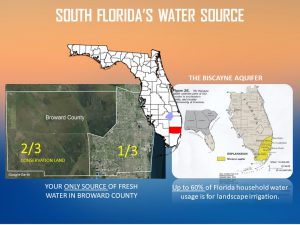Article by UF/IFAS Extension Broward County Urban Horticulture Agent Lorna Bravo
Impacts of Landscapes
Did you know that up to 60% of a Florida household’s total water consumption might be directed at the landscape?
Typical residential landscape plants often receive more water than is required to perform at a satisfactory level. This water applied in excess presents an opportunity for conservation, and the Florida-Friendly Landscaping™ program is ready to help in the urban environments.

The Biscayne Aquifer-The Only Source of Fresh Water in Broward County.
Florida faces clear challenges in protecting both water quality and quantity. As Florida’s population growth increases and the water demands increase, the Florida landscape will play a vital role in future water demands. It is essential to understand Florida’s environmental challenges and understand South Florida’s source of water. The Biscayne aquifer underlies an area of about 4,000 square miles. It is the only water source for nearly 3 million people (all of Dade and Broward Counties and the southeastern part of Palm Beach County in southern Florida). Because the Biscayne aquifer is highly permeable and lies at shallow depths everywhere, it is readily susceptible to contamination, and our urban landscapes use our Biscayne aquifer for watering their landscapes.

We are all connected through water
In Broward County, we have over 1,700 miles of canals. Stormwater and irrigation runoff, contaminant with nutrient leaching, pose significant water quality threats and make their efficient management less sustainable. Proper fertilization and irrigation are critical when reducing nonpoint source pollution, the dominant source of pollution in Broward County’s waterways.
Non-Point Source Pollution
During rain, the pesticides and fertilizers you put on your lawn can be carried by runoff and end up contaminating a stream or wetland dozens of miles away. Contaminants can also be taken for long distances through the air and deposited on land and water by rain or fog. Such examples of pollution are called “nonpoint source” pollution.”If not properly managed, our stormwater runoff ends up in our local bodies of water.

How can we do our Part?

As urban areas are rapidly increasing worldwide, your yard is the first line of defense in preserving Florida’s fragile environment.
What is the Florida-Friendly Landscaping™ Program?
The Florida-Friendly Landscaping™ (FFL) program operates under the UF/IFAS Center for Landscape Conservation & Ecology (CLCE). It is supported by the Florida Department of Environmental protection. The Florida Friendly Landscaping program is an educational outreach program informing homeowners and professionals how they can be more environmentally friendly with their landscape care practices. The Florida-Friendly Landscaping™ Program’s mission is to educate Floridians about science-based, environmentally friendly landscaping practices. It encourages them to conserve and protect our water resources by applying its nine principles. Recognizing the home landscape as part of a more extensive natural system will help us make sound decisions in creating Florida-Friendly yards. It helps protect Florida’s natural environment for future generations.
What are the Florida-Friendly Landscaping™ Program 9 Guiding Principles?

The FFL program has nine guiding principles. The Landscapes must Comply with all existing codes, laws, ordinances, and HOA rules and recognizes yards with two-level recognitions (Silver & Gold). The Florida-Friendly Landscaping™ (FFL) Program recognizes landscapes that use sustainable landscaping practices. Florida-Friendly landscapes minimize the use of potable water for irrigation, avoid the runoff of excess fertilizers and pesticides from the landscape, and provide habitats for wildlife.
What do Florida-Friendly Landscaping™ yards look like?
They can take any form, from more traditional to more natural. It’s how the landscape is designed and maintained that ultimately determines if it’s Florida-Friendly.
What does it take to have your Broward yard Florida-Friendly Landscaping™ recognized?
In order to have your landscape recognized as a Florida-Friendly landscape, you must follow the steps below:
1. You can attend our annual UF/IFAS Extension Broward County’s Florida-Friendly Landscaping training or watch our “Florida-Friendly Landscaping™ in Urban Environments” Video.
Watch Video: https://youtu.be/9LJyTRNk_HM
2. Download checklist from the website:
3.Use the checklist to evaluate your landscape and make any changes needed.
4.If you need help making your landscape more Florida-Friendly, contact our Broward County Extension office, you can contact: UF/IFAS Extension Broward County – UF/IFAS Extension (ufl.edu) and visit our FFL at Resources – UF/IFAS Extension (ufl.edu).
- South Florida Plant Guidelines: ENH1178/EP439: Florida-Friendly Landscaping™ Pattern Book: Sample plant lists and designs for four Florida regions: USDA Hardiness Zones 10A, 10B, and 11, South Florida (ufl.edu)
- Download the Guide to Plant Selection and Landscape Design: https://ffl.ifas.ufl.edu/media/fflifasufledu/docs/FYN_Plant_Selection_Guide_2015.pdf
- Guidelines for Hiring a Florida-Friendly Landscape professional: Hire Florida-Friendly – Florida-Friendly Landscaping™ Program – University of Florida, Institute of Food and Agricultural Sciences – UF/IFAS (ufl.edu)
5. When your landscape is ready, please contact UF/IFAS Extension Broward County office to schedule a site evaluation. You can email browardmg@ifas.ufl.edu.
6. An Extension agent or appointed Broward County FFL representative will visit your landscape and go through the checklist to determine if your landscape is Florida-Friendly.
Florida-Friendly Landscaping™ supporting Programs in Broward County
- Rain Barrel Program. Interested in our Rain barrel Program? Contact our Extension office. browardmg@ifas.ufl.edu. Watch our video: UF/IFAS Extension Broward County Rainwater Harvesting- The Rain Barrel Project – YouTube
- Native Orchid Project. Interested in our Native Orchid Project? Check out our blog: Invite Native Orchids to your Yard – UF/IFAS Extension Broward County (ufl.edu)
- Art in The Garden. Interested to learn about Florida-Friendly Butterfly Gardening? Join our Art in The Garden event on Nov 6th, 2021. We will have native milkweed plants for sale. Art in the Garden 2021 Tickets, Sat, Nov 6, 2021 at 9:00 AM | Eventbrite
Contact us.
You can follow our Facebook page at @http://facebook.com/urbanhortbroward
Visit our Website@ http://sfyl.ifas.ufl.edu/broward/urban-horticulture/
Visit our YouTube Channel at https://tinyurl.com/urbanhhortbcyoutube
Our Twitter page: https://twitter.com/HortUrban
Our Instagram page:@urbanhortbroward
 0
0
